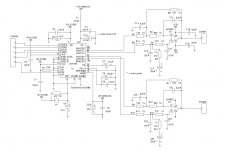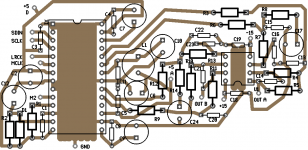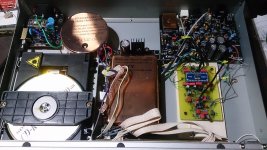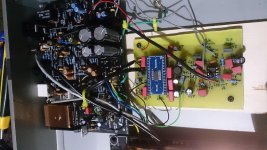So, after having found out that the original Crystal DAC is "toast" (I opened another thread about this initially), I decided to build my own replacement DAC board which will be "piggy-packed" onto the original board and connected to all the relevant digital input and analog output lines as well as power rails. I'll also improve the over all power supply section of the player and make a full recap. I decided to go with CS4398, which represents an improvement over the original DAC chip and also because it was available already soldered on a tiny board which adapts to DIP28 (so I don't have to solder SMD). I've already received it, looks nice. Now I finally got the time to finish the schematic and PCB layout on the computer, I'll make a decent home made PCB for this, but before getting "hands on", I wanted to share these, as maybe some improvements can be made and certainly there are some more knowledgeable people on here and also more experienced than me, especially with this (quite popular) DAC.
I logically based my implementation quite directly on the datasheet but also consulted a lot of existing DAC schematics with this chip, which can be found on the internet. I also had a look at the evaluation board schematic from Crystal. I noticed a strange inconsistency between datasheet and evaluation board: the decoupling caps are 100nF in dastasheet (and most commercially available implementations and also CD players I had a look at the service manual), but in the evaluation board and a couple of schematics which can be found on the net, they are 10nF. Maybe a mistake?
I opted for 100nF, makes more sense and is commonly used.
I did my best regarding ground planes and proximity of decoupling caps, I can't use more advanced techniques, as the PCB will be home made and I use quite basic technique, so some severe limitations here, but I still think it can come to good result.
Comments, ideas and criticism is most welcome.
Please remember this will be "inserted" in the existing circuit, that's why no receiver chip and no clock circuit is shown.
Ah, I hope the reset circuitry is alright, as I based it on the original circuitry which is not exactly the same chip, as already said and I couldn't find a comparable implementation for the CS4398.
Also, please remember that after the simple output filter stage (and conversion to unbalanced) which is shown, there follows another filter stage from the original board, for which I'll upgrade the opamps and change a couple of components for the better.
I logically based my implementation quite directly on the datasheet but also consulted a lot of existing DAC schematics with this chip, which can be found on the internet. I also had a look at the evaluation board schematic from Crystal. I noticed a strange inconsistency between datasheet and evaluation board: the decoupling caps are 100nF in dastasheet (and most commercially available implementations and also CD players I had a look at the service manual), but in the evaluation board and a couple of schematics which can be found on the net, they are 10nF. Maybe a mistake?
I opted for 100nF, makes more sense and is commonly used.
I did my best regarding ground planes and proximity of decoupling caps, I can't use more advanced techniques, as the PCB will be home made and I use quite basic technique, so some severe limitations here, but I still think it can come to good result.
Comments, ideas and criticism is most welcome.
Please remember this will be "inserted" in the existing circuit, that's why no receiver chip and no clock circuit is shown.
Ah, I hope the reset circuitry is alright, as I based it on the original circuitry which is not exactly the same chip, as already said and I couldn't find a comparable implementation for the CS4398.
Also, please remember that after the simple output filter stage (and conversion to unbalanced) which is shown, there follows another filter stage from the original board, for which I'll upgrade the opamps and change a couple of components for the better.
Attachments
So, as nobody commented anything, I decided to go ahead and built it. It ended up being installed on the side of the original board, which isn't as nice regarding length of cables, but was the only solution (case is not high enough for piggybacking). It took some time to implement in the circuit (I also decided to upgrade and improve the PSU, adding one more dedicated voltage regulator and changing the basic 7805 to LM317 for better PSRR, also upgrading capacitors and partial recap. In the end I decided to not use any of the filters on the original board (I think that was a good decision, especially in regards to grounding), as the single output filter shown in the datasheet seems to be sufficient. Resuming in two words: a success. I had music coming out right from the moment on that I first tested it with my DAC board! 
There also was a nasty grounding issue that I then succeeded to eliminate: I had created a ground loop by accident, by using the ground plane from the original PCB for the RCA output. I cut the connection and connected the RCA's ground to the ground on my DAC PCB close to the opamp, bingo! hum was gone. Totally silent! Great sound quality, no noises or artifacts audible, reset circuitry working perfectly, no pops, nothing, all great! This D500SE is totally back to business!
And probably sounding quite a bit better than the original version. Now it's a hotrodded D500SE
Haven't had time to compare extensively to my other TDA154x based players, but listened to a few CDs and I like the sound very much! It's really pristine, sounding very natural, almost a little laid back but without any "smoothing", allows to clearly hear all instruments with ease and sounds lively. Not digital or artificial at all. Not sure if I like it MORE than the TDA's though, as it seems to be a little less "envolving", can't explain well. But maybe that's only with some kind of music and also might need more burn-in.
Photos attached.
Btw, some details regarding implementation: the CS4398 input signals are derived directly from the original board, after the ribbon cable connector and respective 100R resistors (I cut traces to original CS4391 which I also soldered out). The output of the opamps goes over shielded cable to the original board where I installed a 22uF Nichicon Muse Fine gold for each channel and a 560R resistor in series then to RCAs. I cut power to all other original opamps.
Regarding PSUs, I installed a separate LM317 for each of digital +5V, analog +5V for DAC and +5V for clock circuit, and then there's the symmetric rails for the opamps which is unregulated +-9V approx. Works fine. After the rectifiers, I changed filter caps to the following: 1x 3300uF then one 10R resistor and then 1x 4700uF, forming a low pass filter for better filtration.
I also raised capacity of filtration caps on other transformer outputs (for the servo board and the display control board - especially there it made a difference in hum levels, seems that the original 470uF was letting quite a lot of ripple through, Cambridge trying to save a few cents in the wrong place).
I had to do a complete maintenance of the cd mechanism, btw, altough it looks new, seems that the grease was dry, it wasn't reading some brands of CD-Rs, now it accepts them. Still a bit picky with some (mainly the TOC reading, afterwards plays fine the disc), but working perfectly well with others and no problems with factory CDs at all, although heavily scratched ones cause problems sometimes, much more than in philips CDM4 players, I think it's pretty obvious that the Philips mech was much better than this cheap Sony mech. Still it's ok I think, haven't had real problems, no skips (unless some really heavy scratches) and almost all CD-Rs I tested play fine, so laser is in good health and mech working fine. So now I've got a tough decision but I will take my time: shall this hotrod player become my main CD player, taking the place of my also modded Marantz CD40, making it the player of my secondary system? Or will it be the other way round? I have to listen much more to decide this... I'll try some AB comparison also, but first I think I have to match levels (seems output of Cambridge is a little lower).
Bottom line: if you happen to have a D500Se with fried CS4391 (which seems to happen a lot, there was a defective lot of them produced right in the beginning when the IC was launched on the market, they simply burn out after some months of use), it pays out the trouble to build a new DAC board inside the player with better DAC and improve implementation. You obviously could use other DACs... or simply replace the burned out CS4391 if you're really good at smd soldering, as the PCBs are really of low quality, unfortunately, traces easily come off... I'm so glad I didn't go that way. In that case just be totally sure you get a more recently produced CS4391 so it won't fry again! but I think the CS4398 is worth it, seems to be an improvement.
There also was a nasty grounding issue that I then succeeded to eliminate: I had created a ground loop by accident, by using the ground plane from the original PCB for the RCA output. I cut the connection and connected the RCA's ground to the ground on my DAC PCB close to the opamp, bingo! hum was gone. Totally silent! Great sound quality, no noises or artifacts audible, reset circuitry working perfectly, no pops, nothing, all great! This D500SE is totally back to business!
And probably sounding quite a bit better than the original version. Now it's a hotrodded D500SE
Haven't had time to compare extensively to my other TDA154x based players, but listened to a few CDs and I like the sound very much! It's really pristine, sounding very natural, almost a little laid back but without any "smoothing", allows to clearly hear all instruments with ease and sounds lively. Not digital or artificial at all. Not sure if I like it MORE than the TDA's though, as it seems to be a little less "envolving", can't explain well. But maybe that's only with some kind of music and also might need more burn-in.
Photos attached.
Btw, some details regarding implementation: the CS4398 input signals are derived directly from the original board, after the ribbon cable connector and respective 100R resistors (I cut traces to original CS4391 which I also soldered out). The output of the opamps goes over shielded cable to the original board where I installed a 22uF Nichicon Muse Fine gold for each channel and a 560R resistor in series then to RCAs. I cut power to all other original opamps.
Regarding PSUs, I installed a separate LM317 for each of digital +5V, analog +5V for DAC and +5V for clock circuit, and then there's the symmetric rails for the opamps which is unregulated +-9V approx. Works fine. After the rectifiers, I changed filter caps to the following: 1x 3300uF then one 10R resistor and then 1x 4700uF, forming a low pass filter for better filtration.
I also raised capacity of filtration caps on other transformer outputs (for the servo board and the display control board - especially there it made a difference in hum levels, seems that the original 470uF was letting quite a lot of ripple through, Cambridge trying to save a few cents in the wrong place).
I had to do a complete maintenance of the cd mechanism, btw, altough it looks new, seems that the grease was dry, it wasn't reading some brands of CD-Rs, now it accepts them. Still a bit picky with some (mainly the TOC reading, afterwards plays fine the disc), but working perfectly well with others and no problems with factory CDs at all, although heavily scratched ones cause problems sometimes, much more than in philips CDM4 players, I think it's pretty obvious that the Philips mech was much better than this cheap Sony mech. Still it's ok I think, haven't had real problems, no skips (unless some really heavy scratches) and almost all CD-Rs I tested play fine, so laser is in good health and mech working fine. So now I've got a tough decision but I will take my time: shall this hotrod player become my main CD player, taking the place of my also modded Marantz CD40, making it the player of my secondary system? Or will it be the other way round? I have to listen much more to decide this... I'll try some AB comparison also, but first I think I have to match levels (seems output of Cambridge is a little lower).
Bottom line: if you happen to have a D500Se with fried CS4391 (which seems to happen a lot, there was a defective lot of them produced right in the beginning when the IC was launched on the market, they simply burn out after some months of use), it pays out the trouble to build a new DAC board inside the player with better DAC and improve implementation. You obviously could use other DACs... or simply replace the burned out CS4391 if you're really good at smd soldering, as the PCBs are really of low quality, unfortunately, traces easily come off... I'm so glad I didn't go that way. In that case just be totally sure you get a more recently produced CS4391 so it won't fry again! but I think the CS4398 is worth it, seems to be an improvement.
Attachments
Great that you have given a damaged piece of equipment a new lease of life.
Thanks
And it's paying out: I've been listening to it and I enjoy it a lot. The best way I can describe the sound is: it sounds like if the music was being played live. I mean, it seems alive and if you turn your back to the speakers, you feel like if all the musicians were there with you. I've heard and felt this before, I also feel it with my modded Marantz CD40, but here it's even more present, the sound is more pristine, like if a filter had been removed, especially highs and bass, I think mid range is similar. This can be heard especially well with acoustic music, drums, bass lines, or well recorded clean vocals. I've already heard a few songs were I like it more in the over all result than my CD40. That's the best result I've had in a long time, haven't come across a player here that would beat my CD40 (I know there are better players, of course, but you don't come across them easily), and believe me, I've come across a lot of players (especially as I repair them, for example). I think the "curtain" which seems in front of the sound in case of the CD40 when compared to the cambridge, might be the NOS artifacts superimposed on the waveform. But maybe then again it's not, as I can't hear that difference when I change my CD40 to OS-mode (yes, I made it switchable but I mostly use it in Non-OS). There are still a few occasions when I think the CD40 sounds more musical. But it's very rare and maybe it's coloration from TDA1541, like with tubes, for example. And there are quite a few I like the hotrodded D500 more. Instrument separation and stereo image is also great, which surprises me a bit, as I didn't touch the clock circuitry, normally this only gets improved in average players when installing a dedicate clock circuit. I think this means jitter is quite low. I don't have the equipment to measure that, though.
Still haven't had the time to do direct A-B yet. I think I have to match levels... Will get back once I've managed to do that. But for now, the over all result is really great. And I'm not even sure if it has finished the "burn-in" phase yet...
- Status
- This old topic is closed. If you want to reopen this topic, contact a moderator using the "Report Post" button.



